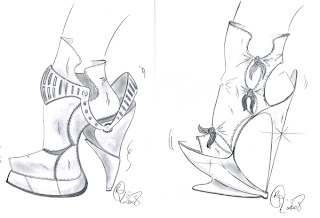A shoe is an item of footwear intended to protect and comfort the human foot while doing various activities. Shoes are also used as an item of decoration. The design of shoes has varied enormously through time and from culture to culture, with appearance originally being tied to function. Additionally fashion has often dictated many design elements, such as whether shoes have very high heels or flat ones. Contemporary footwear varies widely in style, complexity and cost. Basic sandals may consist of only a thin sole and simple strap. High fashion shoes may be made of very expensive materials in complex construction and sell for thousands of dollars a pair.
Parts
Sole
The bottom of a shoe, the part that is intended to come in repeated contact with the ground, is called the sole. Soles have been made from plant fibers, leather, wood, rubber, synthetics, plastic, and various combinations of these materials. Soles can be simple, a single material in a single layer, or they can be complex with multiple structures or layers and materials.
Insole
The insole is the interior bottom of a shoe, which sits directly beneath the foot under the foot-bed (also known as sock liner). The purpose of insole is to attach to the lasting margin of the upper, which is wrapped around the last during the closing of the shoe during the lasting operation. Insoles are usually made of cellulosic paper board or synthetic non woven insole board. Many shoes have removable and replaceable foot-beds. Extra cushioning is often added for comfort (to control the shape, moisture, or smell of the shoe) or health reasons (to help deal with defects in the natural shape of the foot or positioning of the foot during standing or walking). Basically, this is a main part of shoes which can absorb foot sweat. Foot-beds should typically use foam cushioning sheets like latex and EVA, which provide good wearing comfort of the shoe.
Out-sole
The out-sole is the layer in direct contact with the ground. Dress shoes often have leather or resin rubber out-soles; casual or work-oriented shoes have out-soles made of natural rubber or a synthetic material like Polyurethane. The out-sole may comprise a single piece, or may be an assembly of separate pieces of different materials. Often the heel of the sole has a rubber plate for durability and traction, while the front is leather for style. Specialized shoes will often have modifications on this design: athletic or so called cleated shoes like soccer, rugby, baseball and golf shoes have spikes embedded in the out-sole to grip the ground.
Mid-sole
The layer in between the out-sole and the insole that is typically there for shock absorption. Some types of shoes, like running shoes, have another material for shock absorption, usually beneath the heel of the foot, where one puts the most pressure down. Different companies use different materials for the mid-soles of their shoes. Some shoes may not have a mid-sole at all.
Heel
The bottom rear part of a shoe is the heel. Its function is to support the heel of the foot. They are often made of the same material as the sole of the shoe. This part can be high for fashion or to make the person look taller, or flat for a more practical and comfortable use.
Vamp (upper)
Every shoe has an upper part that helps hold the shoe onto the foot. In the simplest cases, such as sandals or flip-flops, this may be nothing more than a few straps for holding the sole in place. Closed footwear, such as boots, trainers and most men's shoes, will have a more complex upper. This part is often decorated or is made in a certain style to look attractive.
Lateral and medial
The outside part of the shoe is referred to as the lateral and the inside facing part of the shoe is the medial. This can be in reference to either the out-sole or the vamp.
Welt
A welt is a strip of leather, rubber, or plastic that is stitched to the upper and insole of a shoe, as an attach-point for the sole.

























































